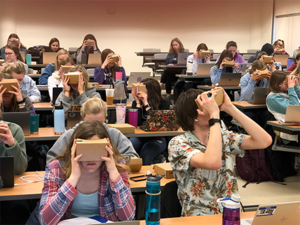Difference between revisions of "Teaching with phones in VR headsets"
| (7 intermediate revisions by the same user not shown) | |||
| Line 4: | Line 4: | ||
==The big question== | ==The big question== | ||
| − | ''' | + | '''Can students learn from videos on phones in VR headsets?''' |
==Overview== | ==Overview== | ||
| + | VR headsets that hold phones are an inexpensive way to experiment with VR. The headsets are nothing more than a container that holds a phone and only allows each eye to see half of the phone's screen. Special videos are created for this type of viewing that show the view for the left eye on the left half of the screen and the view for the right eye on the right side of the screen when the phone is held in landscape orientation. | ||
| + | Users can create their own videos or search sources like YouTube for pre-made videos on a wide variety of subject matter. | ||
==Goals and objectives== | ==Goals and objectives== | ||
| + | |||
| + | === Determine the viability of these types of videos as an effective educational tool. === | ||
| + | |||
| + | * Use 3D videos in a course to demonstrate a concept not easily conveyed in other ways. | ||
| + | * Talk to students to determine their degree of acceptance. | ||
| + | [[File:Cardboard1Small.png|alt=Cardboard|thumb|Students watching videos on Google Cardboard ]] | ||
==Piloting the idea== | ==Piloting the idea== | ||
===Pilot work=== | ===Pilot work=== | ||
| − | We | + | We looked at four different [[VR headsets for phones]]: Atlasonix, VR Shinecon, VR Wear, and Google Cardboard. In the end, we went with Google Cardboard because, since the price was so low, we could afford to get enough to cover an entire class enrollment of about 60. |
===Participants=== | ===Participants=== | ||
| − | The | + | ==== Winona State University ==== |
| − | * | + | A pediatric nursing course was selected for the trial. |
| + | |||
| + | The concept of autism is difficult to purvey. You cannot read a book or view a Powerpoint and get a feel for what is means to see the world through autistic eyes. 3D, immersive videos were found in YouTube that demonstrated a view of the world for a child with severe autism. Each student used their own phone in a Google Cardboard to view the videos. | ||
| + | * | ||
| + | |||
==Results== | ==Results== | ||
| + | Immersive videos showed the world and created the sounds as they appear to someone with autism. Students watched the videos and then discussed what they experienced with the rest of the class. | ||
==Assessment vehicle== | ==Assessment vehicle== | ||
| − | + | Student reactions to the experience were mixed. | |
| − | + | ||
| − | * | + | * Students found the videos highly informative and educational. They saw and heard the world in a way they had never experienced before. They reported a new understanding of what it meant to be autistic. |
| + | * A minority of the class had issues with the videos. In most cases, it was a problem with the video not loading properly or not playing smoothly. This could be a factor of the WSU network or a matter of the students using older phones. No further investigation was done. | ||
==Recommendations and observations== | ==Recommendations and observations== | ||
| − | + | There are definitely subjects in which these types of videos are very useful. Demonstrating autism was easily accomplished here while it would have been impossible in other environments, like a lecture. | |
| + | |||
| + | Some other thoughts: | ||
| + | |||
| + | * Choose the subject carefully. As cool as immersive videos are, do not fall into the technology-for-technology's-sake trap. | ||
| + | * Most students carry phones with them. There were a few that did not have them and they had to share with a neighbor. | ||
| + | * Make sure the network is fast enough to support 60 simultaneous streams of a video. It may be true that phone type and/or age are a factor here, too. | ||
| + | * Google Cardboard was inexpensive and readily available. The issue in the post-pandemic world is sanitation. It is pretty had to sanitize cardboard. | ||
==Tell us your story== | ==Tell us your story== | ||
Latest revision as of 15:03, 19 October 2021
The big question
Can students learn from videos on phones in VR headsets?
Overview
VR headsets that hold phones are an inexpensive way to experiment with VR. The headsets are nothing more than a container that holds a phone and only allows each eye to see half of the phone's screen. Special videos are created for this type of viewing that show the view for the left eye on the left half of the screen and the view for the right eye on the right side of the screen when the phone is held in landscape orientation.
Users can create their own videos or search sources like YouTube for pre-made videos on a wide variety of subject matter.
Goals and objectives
Determine the viability of these types of videos as an effective educational tool.
- Use 3D videos in a course to demonstrate a concept not easily conveyed in other ways.
- Talk to students to determine their degree of acceptance.
Piloting the idea
Pilot work
We looked at four different VR headsets for phones: Atlasonix, VR Shinecon, VR Wear, and Google Cardboard. In the end, we went with Google Cardboard because, since the price was so low, we could afford to get enough to cover an entire class enrollment of about 60.
Participants
Winona State University
A pediatric nursing course was selected for the trial.
The concept of autism is difficult to purvey. You cannot read a book or view a Powerpoint and get a feel for what is means to see the world through autistic eyes. 3D, immersive videos were found in YouTube that demonstrated a view of the world for a child with severe autism. Each student used their own phone in a Google Cardboard to view the videos.
Results
Immersive videos showed the world and created the sounds as they appear to someone with autism. Students watched the videos and then discussed what they experienced with the rest of the class.
Assessment vehicle
Student reactions to the experience were mixed.
- Students found the videos highly informative and educational. They saw and heard the world in a way they had never experienced before. They reported a new understanding of what it meant to be autistic.
- A minority of the class had issues with the videos. In most cases, it was a problem with the video not loading properly or not playing smoothly. This could be a factor of the WSU network or a matter of the students using older phones. No further investigation was done.
Recommendations and observations
There are definitely subjects in which these types of videos are very useful. Demonstrating autism was easily accomplished here while it would have been impossible in other environments, like a lecture.
Some other thoughts:
- Choose the subject carefully. As cool as immersive videos are, do not fall into the technology-for-technology's-sake trap.
- Most students carry phones with them. There were a few that did not have them and they had to share with a neighbor.
- Make sure the network is fast enough to support 60 simultaneous streams of a video. It may be true that phone type and/or age are a factor here, too.
- Google Cardboard was inexpensive and readily available. The issue in the post-pandemic world is sanitation. It is pretty had to sanitize cardboard.
Tell us your story
- Do you have experience with augmented or virtual reality in the classroom?
- Did something in this article help you make a decision about your curriculum or cause you to try something new?
- Do you have questions about this project or the results?
Please share any experience, reactions, or questions with us so we can add to the content of this article and make it more relevant for the next person. Email your input to nthomes@winona.edu and we will add it to this article. Thanks.
More information
Want more information on the McLAB or have an idea you would like to pursue? Contact Norb Thomes at (507) 457-5043 or nthomes@winona.edu.
Overview of the McLABRead the full overview of the Mobile Computing Laboratory project. |
Related wiki topics |

